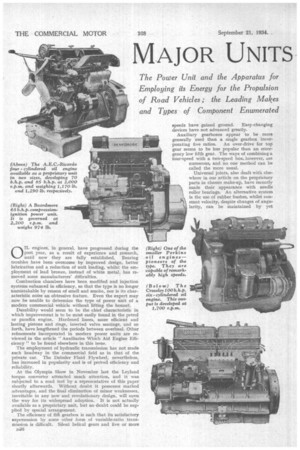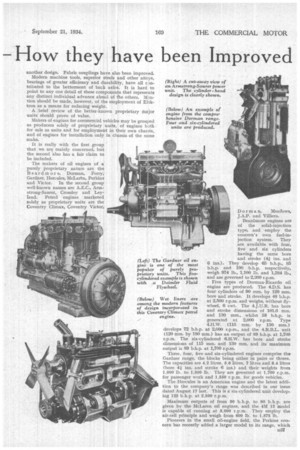MAJOR UNITS
Page 94

Page 95

Page 96

If you've noticed an error in this article please click here to report it so we can fix it.
How they have been Improved
The Power Unit and the Apparatus for Employing its Energy for the Propulsion of Road Vehicles ; the Leading Makes and Types of Component Enumerated
(DIL engines, in general, have progressed during the past year, as a result of experience and research, until now they are fully established. Bearing troubles have been overcome by improved design, better lubrication and a reduction of unit loading, whilst the employment of lead bronze, instead of white metal, has removed some manufacturers' difficulties.
Combustion chambers have been modified and injection systems enhanced in efficiency, so that the type is no longer unmistakable by reason of smell and smoke, nor is its characteristic noise an obtrusive feature. Even the expert may now be unable to determine the type of power unit of a modern commercial vehicle without lifting the bonnet.
Durability would seem to be the chief characteristic in which improvement is to be most easily found in the petrol or paraffin engine. Hardened liners, more efficient and lasting pistons and rings, inserted valve seatings, and so forth, have lengthened the periods between overhaul. Other refinements incorporated in modern power units are reviewed in the article " Auxiliaries Which Aid Engine Efficiency" to be found elsewhere in this issue.
The employment of hydraulic transmission has not made such headway in the commercial field as in that of the private car. The Daimler Fluid Flywheel, nevertheless, has increased in popularity and is of proved efficiency and reliability.
At the Olympia Show in November last the Leyland torque converter attracted much attention, and it was subjected to a road test by a representative of this paper shortly afterwards. Without doubt it possesses marked advantages, and the final elimination of minor weaknesses, inevitable in any new and revolutionary, design, will open the way for its widespread adoption. It is not actually available as a proprietary unit, but no doubt could be supplied by special arrangement. The efficiency of the gearbox is such that its satisfactory supersession by some other form of variable-ratio transmission is difficult. Silent helical gears and five or more ol.01. speeds have gained ground. Easy-changing devices have not advanced greatly.
Auxiliary gearboxes appear to be more generally used than a single gearbox incor porating five ratios. An over-drive for top gear seems to be less popular than an emergency low fifth gear. The ways of combining a four-speed with a two-speed box, however, are numerous, and no one method can be called the more usual. , Universal joints, also dealt with elsewhere in our article on the proprietary parts in chassis make-up, have recently made their appearance with needle roller bearings. An alternative system is the use of rubber bushes, whilst constant velocity, despite changes of angularity, can be maintained by yet another design. Fabric couplings have also been improved. Modern machine tools, superior steels and other alleys, bearings of greater efficiency and durability, have all c mtributed to the betterment of back axles. It is hard to point to any one detail of these components that represents any distinct individual advance ahead of Am others. Mmtion should be made, however, of the employment of Elektron as a means for reducing weight.
A brief review of the better-known proprietary major units should prove of value.
Makers of engines for commercial vehicles may be grouped as producers solely of proprietary units, of engines both for sale as units and for employment in their own chassis, and of engines for installation only in chassis of the same make.
It is really with the first group that we are mainly concerned, but the second also has a fair claim to be included.
The makers of oil engines of a purely proprietary nature are the B eardm or e, Dorman, Ferry, Gardner, Hercules, McLartn, Perkins and Victor. In the second group well-known names are A.E.C., Armstrong-Saurer, Crossley and Leyland. Petrol engines marketed solely. as proprietary units are the Coventry Climax, Coventry Victor,
Dorman, Meadows, J.A.P. and Villiers, Beardmore engines are of the solid-injection type, and employ the concern's own fuel-injection system. They are available with four, five and six cylinders having the same bore and stroke (lb ins. and 6 ins.). They develop 65 b.h.p., 85 b.h.p. and 100 b.h.p. respectively, weigh 974 lb., 1,100 lb. and 1,284 lb., and are governed to 2,200 r.p.m.
Five types of Dorman-Ricardo oil engine are produced. The 4.D.S. has four cylinders of 90 mm. by 120 mm. bore and stroke. It develops 48 bap. at 2,500 r.p.m. and weighs, without flywheel, 6 cwt. The 4.J.U.R. has bore and stroke dimensions of 101.6 mm. and 130 mm., whilst 58 b.h.p. is generated at 2,000 r.p.m. Type 4.II.W. (115 mm. by 130 mm.) develops 72 b.h.p. at 2,000 r.p.m., and the 4.R.B.L. unit (120 mm. by 180 ram.) has an output of 89 b.h.p. at 1,700 r.p.m. The six-cylindered 6.H.W. has bore and stroke dimensions of 115 mm. and 130 mm. and its maximum output is 89 b.h.p. at 1,700 r.p.m.
Three, four, five and six-cylindered engines comprise the Gardner range, the blocks being either in pairs or threes. The capacities are 4.2 litres, 5.6 litres, 7 litres and 8.4 litres (bore 41 ins and stroke 6 ins.) and their weights from 1,000 lb. to 1,500 lb. They are governed at 1,700 r.p.m. for passenger work and 1,550 r.p.m. for goods vehicles.
The Hercules is an American engine and the latest addition to the company's range was described in our issue dated August 17 last. This is a six-cylindered unit developing 126 b.h.p. at 2,500 r.p.m.
Maximum outputs of from 50 b.h.p. to 90 b.h.p are given by the McLaren oil engines, and the 4M 12 model is capable of running at 3,000 r.p.m. They employ the air-cell principle and weigh from 600 lb: to 1,975 lb.
Pioneers in the small oil-engine field, the Perkins concern has recently added a larger model to its range, which D37 Fl)wheel.
(Below) Wet liners are among the modern features of design incorporated in this Coventry Climax petrol engine.
now comprises the Vixen, Fox, Wolf and Leopard models. These are of 2.2 litres, 2.42 litres, 2.8 litres and 4 litres respectively. The new engine develops 60 b.h.p. and can be run up to 3,000 r.p.m,
The Ferry engine is not yet in production, but a model is in the service of a prominent bus operator, The Victor • is a horizontally opposed twin, and has been employed for tractor propulsion.
The popular Coventry • Climax petrol engines are the L.6 and B.4 models. They have six cylinders (34-in, bore and 5-in, stroke) and four cylinders (34-in. bore and 5i-in. stroke) respectively. The latter type is of specially modern design and incorporates wet liners.
A new Coventry Victor of the horizontally opposed type is a four-cylindered, 16 b.h.p. engine.
The petrol-engine products of the Dorman and Meadows concerns are widely known and, in the main, are not greatly changed. The J.A.F. engines are suitable for light vans and industrial trucks.
Villiers two-stroke power units are giving reliable service in large numbers of small vehicles of many types, their extreme simplicity and economy having done much to bring them to the position of prominence they now hold.
Borg and Beck and David Brown clutches are widely used and are of high repute. Centres are produced by F. J. Evans, Ltd.
Armstrong-Saurer gearboxes and back axles are available as proprietary units. Leading makers of purely proprietary gearboxes are: the Turner concern, for vehicles up to 2Atons and to customers' requirements; the Laycock company, which has just introduced a four-speed box with silent second and third gears and a synchronizing clutch, and the David Brown concern. The E.N.V. Engineering. Co.. Ltd., produces the Wilson preselectivo and self-changing box.
Other well-known names are John Holroyd, Moss, and Coventry Victor, whilst the Maybach range of transmission units and automatic gear-changing mechanism must not be overlooked.
Three and four-speed gearboxes for engine 'powers from 18 b.h.p. to 120 b.h.p. are renowned products of Henry Meadows, Ltd. They are made for attachment tO the bell housing and are suitable for either normal or forwardcontrol chassis and for side or central change. Stiff, short shafts, wide gears and large ball and roller bearings are features of their design.
David Brown gearboxes are made in two standard sizes for torques of 3,000 lb.-ins. and 4,000 lb.-ins. respectively. They are available for mounting amidships or as a unit with the engine. The concern is prepared to manufacture gearboxes of special type to requirements.
The advantages of the Daimler Fluid Flywheel and the Leyland torque converter are too well known to require emphasizing here.
Kirkstall back axles and bogies are widely employed. They are suitable for all standard types,of brake gear, and, in many cases, employ .Elektron where low weight is desirable. Other well-known makes are Moss, David Brown, E.N.V., Turner, etc.
Some of the concerns listed below specialize in the production of gears, parts and assemblies rather than in coinplete units.
.Arrn'strong.Sanrer Commercial Vehicles, Ltd., -Thames House, West• adneter, London, S.W.1. Associated Equipment Co., Ltd., Southall. Middlesex. Beardmare Diesels, Ltd,; 56, Victoria Street, London, S.W.1, Buda Co. ;England), Harvey Works, NVembley, Middlesex. Coventry Climax Foigines,• Ltd., Friars' Road, Coventry. Coventry-Victor Motor Co., Ltd., Coventry. Crossley Motors, Ltd., Gorton, Manchester. W. IL Dorman and Co., Ltd., Stafford. Ferry Engine Co., Ltd., Wools-ton, Southampton. Antomotitle •Prodtiets Co., Ltd., Longhorn. Street, Landon, W.1. (Hercules). Leyland Mote-re, Ltd.; Leyland, Lands. J. and H. McLaren, Ltd., Midland Engine Works, Leeds O. Henry Meadow's; Ltd.,,Fallini,,a Park, Wolverhampton. Norris Henty and Gardners, Ltd., Patrieroit, Lanes. F. Perkins, Ltd., Peterborough. .1-J. A. Prestwich and. Co:, Ltd.. Northumberland Park, London, N.17. Villiers Engineering Co., Ltd., Marston Road, Wolverhampton.
Clutches.
Borg and Beck Co., Ltd., Brock'House, E,anghatri Street, London, W.1. David Brown and Sans (}Dodd.), Ltd., Huddersfield. F. 5. Evans, Ltd., Grange Road, London, N.W.10. Henry Meadows, Ltd„ Fallings Park, Wolverhampton.
Gearboxes. Gears.
Armstrong-Sourer Commercial Vehicles, Ltd., Thames House, West. nainstar, London, S.W.L. David Brown and Sons-Mudd.); Ltd., Huddersfield. Coventry-Victor Motor Co., Ltd.. Coventry, Frighh Steel Corporation, Ltd., Sheffield. Elephant Motors, Ltd., Newington Causeway, London, S.E.1. E.N.V. Engineering Co., Ltd., 4-5, HyVhe Road, London, N.W.10. Jahn Helroyd and Co., lad., Milnrow, Lanes. Laycock
Engineering Co., MiAbonses, Sheffield, Moss Gear yburn, Birmingham. Ernst Schneider, 18, Victoria Street, Co.,London, S.W.1. (Maybach.) Thomos Smith and Sons, al Saitley, Ltd., Adderley Road, Birmingham. .1. Stone and 00., Ltd.. Deptford, London, S.E.14. Turner's Motor Manufacturing-Co., Ltd., Wulf:awl Works, Lever Street, Wolverhampton. Henry Meadows, Ltd., Fallings Park, Wolverhampton.
Fluid Transmission.
Daimler Go., Ltd.. Coventry. Leyland Motors, Ltd., Leyland, Lance.
Back Ax1ES.
Arrnstrong-Sahrer Commercial Vehicles, Ltd., Thames House, West minster, Londen, florid Brown and Sons (Huddersfield', Lid., Huddersfield, E.N.V. Engineering Co., Ltd., 4-5 ITythe Road, London, •N.W.10. Xirkstall Forge, Ltd., Leeds 5. Moss Gear Co., Ltd., • Tyburn, Birmingham. • Turner's Motor Manufacturing Co., Ltd,, Lever Street., Wolverhampton.








































































































































































